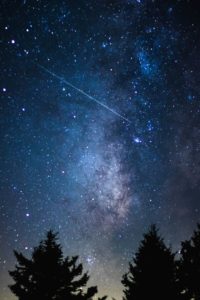
“Just one more” is certainly high up on the list of Inadvisable Actions, whether that refers to just one more cheese puff (Who really believes one bag truly holds thirteen servings instead of four?!), one more episode in a ten-hour episode of binge-watching, or just one more hand of poker, sure to win back all the losses mounted in a gambling streak. It’s a phrase I’ve learned to avoid, but the last week, it’s tempted me nightly.
The Insomnia Edition is something I’ve learned to live with. Though losing a few hours of sleep three or four times a week sometimes leaves me groggy, it’s tremendous for a writer, those quiet hours when the whole house sleeps, except for the Red Dog who slips downstairs with me, keeping my company while I write in the dead of night.
But the last ten days, the Perseid meteor shower has been in full swing, so instead of writing, I’ve dragged a quilt and pillows—and my husband—out to lie on the balcony out back and watch the shooting stars streak across the sky. My eyes grow heavy, yet I say, “Just one more,” and we watch, talking quietly, memories streaming from us like the bright sparks shed from the comet. Something about the majesty of the celestial drama has a way of making my own problems feel very small and temporary. Cosmic therapy, indeed!
The Perseids are one of the most famous and reliable meteor showers seen in the Northern Hemisphere. They peak on the 12th of August, though they are visible in July. Meteors are caused from cosmic debris streaming from the tail of a comet; as the comet passes near the sun, some of its ice evaporates, creating a “dust trail” of sublimated fragments. The dust trail is affected by the Earth’s gravity and that of other planets. Most meteors are smaller than a grain of sand and burn up over fifty miles from the earth’s surface, although some survive their scorching atmospheric entry and impact the ground.
Meteors are named not after the parent comet (the Swift-Tuttle in the case of the Perseids) but rather the nearest constellation or bright star with a Greek or Roman letter. Thus, the Perseids are named after the constellation Perseus, he who beheaded the Gorgon Medusa, and vanquished the sea serpent to save the Princess Andromeda. The Perseids are sometimes called the “tears of St. Lawrence” by Catholics, since they occur on the date of his martyrdom, burned on a gridiron, and a Mediterranean legend says they symbolize the sparks of that fatal fire. The Perseids have been commemorated in song, most notably John Denver’s “Rocky Mountain High” and more recently “RPG” and “R.Y.U.S.E.I” by the Japanese bands Sekai no Owari and Sandaime J Soul Brothers, respectively.
A meteor shower may contain up to a thousand meteors an hour, but a meteor storm may peak at over two hundred thousand meteors an hour! A storm is caused by a young meteor stream, with the mass still concentrated near the parent’s orbit. The Leonid meteor shower peaks on November 17, but every thirty-three years, the Leonids exhibit a meteor storm. Mark your calendars for 2035!
Tonight I could really use the sleep, but I know the sky will call me at 2 a.m. for another night’s viewing of celestial fireworks.
Just one more.
Recent Comments